For Speed and Creed: The Fast and Furious Franchise
Early in Fast & Furious 6 (2013), as Dom (Vin Diesel) and his team are regrouping after their first chastening encounter with Luke Evans's supervillain Owen Shaw, Roman (Tyrese Gibson) stops to voice his disbelief at what they've just witnessed: "This is crazy . . . So, now we've got cars flying through the air? On some 007-type shit? This is not what we do!" It's a throwaway gag, one that's designed to ease the transition from the previous scene — a high-speed, multi-vehicle pursuit across London. But it also captures just what makes Dom and his team so compelling as protagonists: the fact that they're outsiders, a gang of street racers who started out stealing TV/DVD players in The Fast and the Furious (2001), before stumbling — several films (and multiple misadventures) later — into the high-stakes arena of counterterrorism and international espionage.
Time and again, then, Dom and his team find themselves taking on the type of crisis scenarios that are usually reserved for superspies like James Bond. In the most recent films in The Fast Saga, they battle mysterious terrorists such as Cipher (Charlize Theron) — a master hacker who attempts to use her arsenal of high-tech drones to initiate a global nuclear war. Yet, each time, they find a way to win, improvising ingenious solutions that hark back to the beginnings of the franchise. Indeed, the team's responses to the schemes of their adversaries are often quite low-tech in design, favoring tools and vehicles that are found in the auto shop as opposed to the military base or laboratory. And, no matter what befalls them, Fast & Furious's heroes prevail not because of any previous spy training, but because of skills and alliances they honed on the street racing scene.
In its repeated staging of these underdog victories, the franchise articulates a populist image of working-class heroism that merits closer attention. Scholars and critics tend to neglect class when discussing The Fast Saga, focusing instead on questions of race and gender.1 However, Justin Lin — director of five installments in The Fast Saga — suggests the series is "more about class than race," observing that a key reason for the franchise's success is the way it centers working-class values that cut across racial and national lines.2
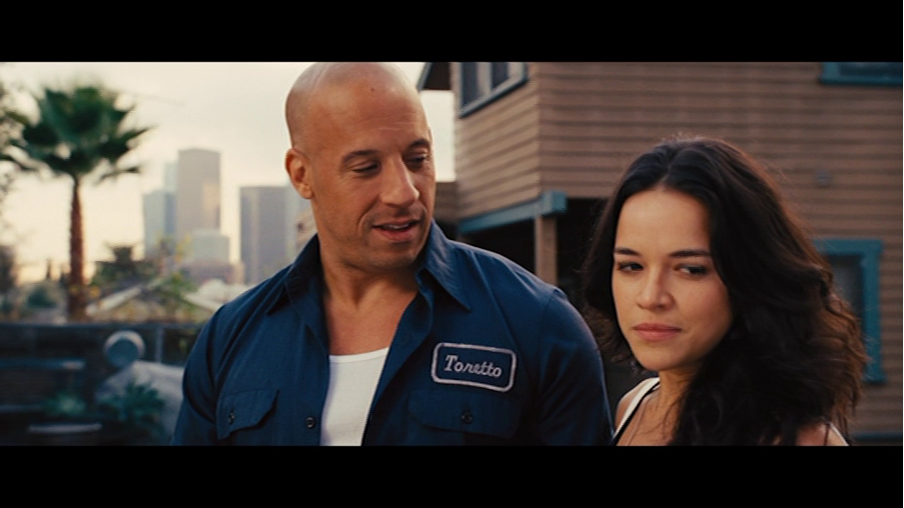
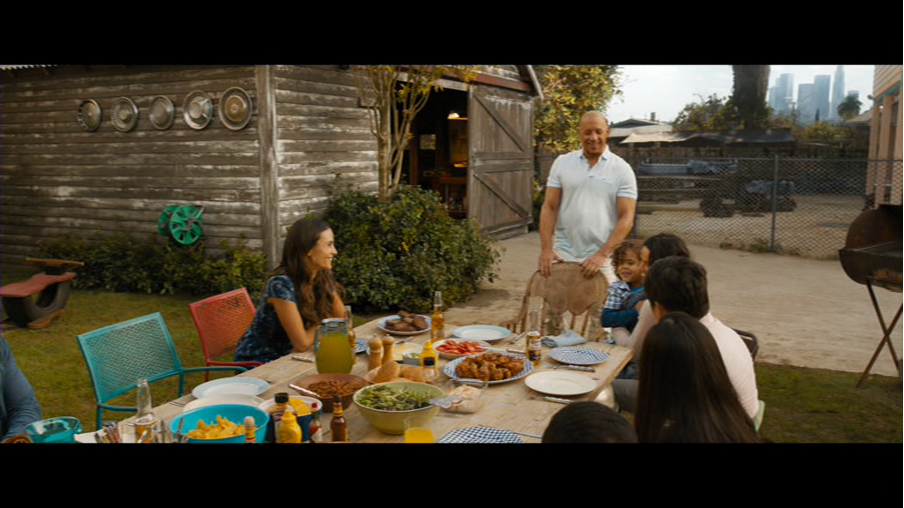
This emphasis on class is evident in the important continuities that exist between the early and later films. Even as the franchise rebranded after Fast Five (2011), evolving into a series of Mission: Impossible-style blockbusters about the protagonists' efforts to thwart elaborate terrorist plots, Dom and his team were still shown to possess the same strong affinity with working-class and street culture that they did in the first film.3 Throughout the franchise, Dom continues to wear the gray and blue work shirts that he wore in The Fast and the Furious, for example, while both Fast & Furious 6 (2013) and F9 (2021) end with backyard cookouts at the original Toretto home — a two-story house situated in the historically working-class neighborhood of Echo Park, Los Angeles. (see figs. 1 and 2).4
The recurring use of these sites and symbols performs a dual function within the broader narrative. Firstly, it reminds audiences of the heroes' humble origins, underscoring their remarkable journey over the course of the franchise — from lowly street racers to globetrotting superspies. Second, it frames Dom and his team in terms of a very specific image of working-class identity, one deeply invested in traditional forms of blue-collar work. After all, Diesel's character is introduced in The Fast and the Furious not only as an elite-level street racer, but as an auto mechanic, too; throughout the sequels he continues to be pictured in the garage, tuning up his muscle cars (see figs. 3 and 4).
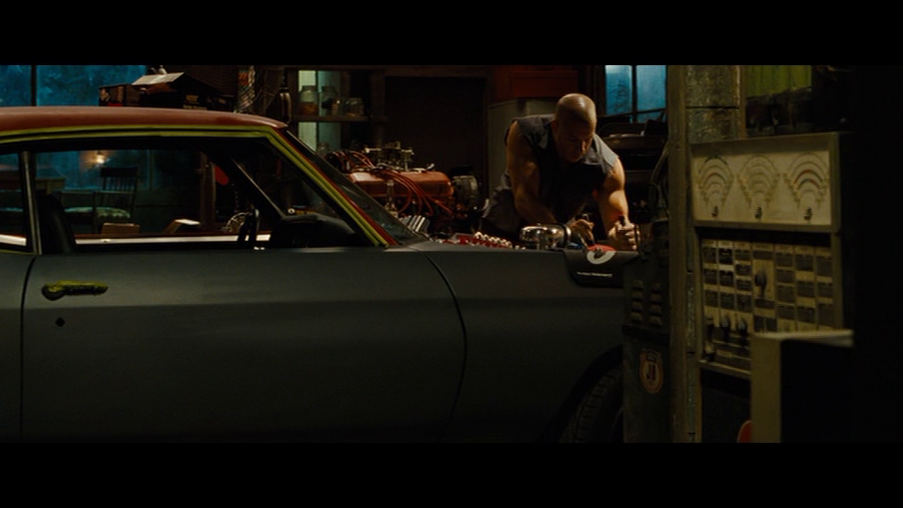
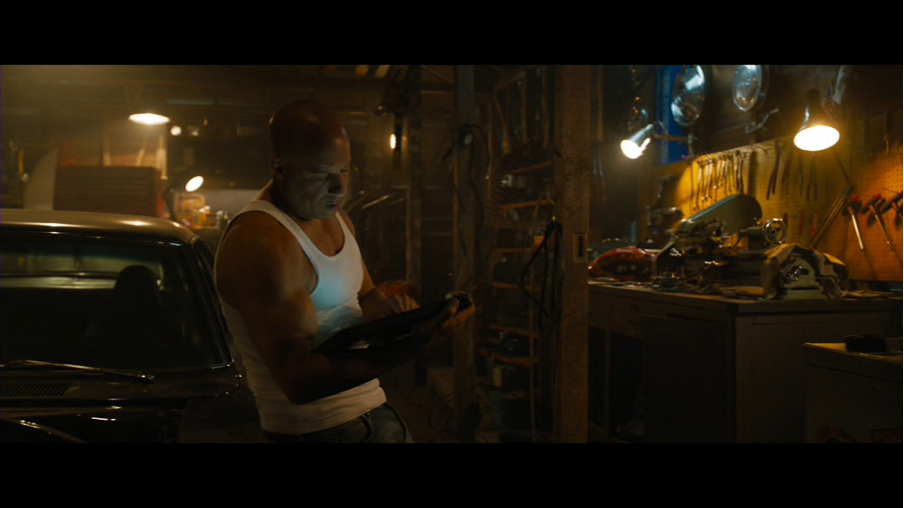
Although these shots only appear fleetingly, operating as pit stops between the extraordinary action scenes, they nevertheless establish Dom's capacity for hard work and enterprise — qualities long upheld as the archetypal values of the American working class. Indeed, the iconography here — oil-stained jeans, tank top and an assortment of tools — is that of the working man, illustrating that while so much of Dom's driving ability may appear effortless and natural, it's also a product of the countless hours that he spends in the garage (and on the race track) honing his craft.
Across The Fast Saga, therefore, the garage emerges as a key site for the assertion of Dom's masculine credentials: it signals his willingness to get his hands dirty, to take the kinds of decisive action that the action genre demands.5 In her influential work on Hollywood action cinema, Yvonne Tasker notes how dominant ideas of class and gender intersect in the figure of the male star. Here, Tasker points to the way in which the muscular, "worked-on" body of the hero transforms labor into spectacle, arguing that this is "central to the articulation of a class-based definition of masculinity" within the action film.6 Such dynamics are clearly at play in the portrayal of Dom, a character whose every action and utterance seems designed to uphold the idea that "real" men work with their hands: see, for instance, the climactic fight in Furious 7 (2015), where Diesel's hero discards his shotgun so that he can go toe-to-toe with his enemies using a wrench and his bare fists. From this perspective, the garage is not just a site for working on cars; it's also a space where Dom and his team work on their own bodies, prepping themselves for the inevitable conflicts to follow. Indeed, the fact that we never see the team training or working out in these films is itself significant, suggesting that their ripped muscles are a product of time spent in the garage, rather than any effort to build up their bodies for frivolous display.7
With his no-nonsense attitude and commitment to the value of hard work, Dom recalls earlier blue-collar heroes such as John McClane (Bruce Willis) in Die Hard (1988) and Sylvester Stallone's characters in the Rocky franchise (1976-) and Over the Top (1987). Jon Kraszewski points to a deep-seated "nostalgia" that runs throughout this cycle of 1980s urban action films, which take place in and around former industrial spaces and feature protagonists associated with manual labor. For Kraszewski, the portrayal of scrappy heroes like Rocky evidences a longing for a more "authentic" masculinity, one that was supposedly lost in America's transition from an industrial to a post-industrial economy.8 Pete Deakin, in his discussion of white masculinity-in-crisis cinema, identifies the same type of longing in a series of action films released at the turn of the millennium, including the Mel Gibson vehicle Payback (1999). Deakin reads these films in terms of the "demise of the blue-collar manufacturing and physical industries" in late twentieth-century America, as well as the contemporaneous growth of other types of labor in the service and commercial sector.9 Here, he argues that films like Payback tapped into long-standing anxieties around the "de-tooling" of American men and what that meant for (white) masculinity, by pitting their "tough-guy" heroes against white-collar characters (and organizations) who are portrayed as untrustworthy, bureaucratic and weak.10
A similar nostalgia is found within The Fast Saga, only here it's transferred onto characters of color. In contrast to the predominantly white heroes of 1980s and '90s Hollywood action cinema, Dom and his team are drawn from a range of racial and ethnic groups, with Dom himself a multiracial character who is shown to have Central American ancestry.11 This multiculturalism produces "a working-class bilingual aesthetic" that Mary Beltrán traces back to the franchise's focus on street racing.12 As explored by Beltrán, street racing is a subculture marked by its racially diverse mix of participants, with Asian American, African American and Latinx youths having played a major role in the street racing "craze" that emerged out of 1990s California, and which fed into the release of the first Fast & Furious film. Beltrán's analysis is crucial for uncovering the franchise's complex representational politics, and we can combine her insights with the critiques of contemporary action cinema offered by Tasker, Kraszewski and Deakin, which examine how the genre has articulated class-based ideas of masculinity.13
Drawing on these critiques is useful because the most recent films in The Fast Saga employ the same dyadic structure that we see in the likes of Payback. As Dom and his team make the transition from street racers to superspies, they're forced to work with a range of military and government representatives. Here, the franchise goes to great lengths to place its heroes in opposition to the agency, juxtaposing their flexibility and improvisation with the cold, constrained demeanor of the government and military bureaucrats who serve as stand-ins for a professional-managerial class. This dynamic is particularly apparent in the eighth film, The Fate of the Furious (2017), which sees the team working under the supervision of Little Nobody, a young agent played by Scott Eastwood.
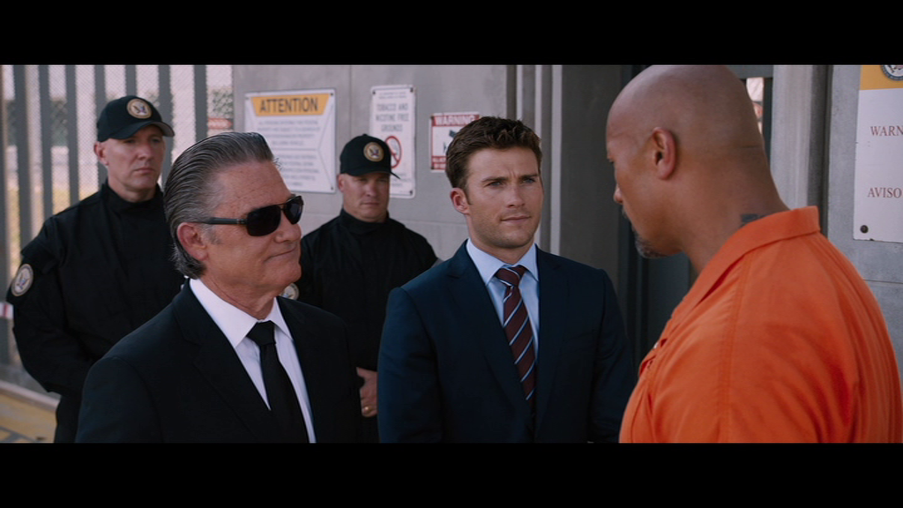
In both action and appearance, Little Nobody is the antithesis of the protagonists when he first appears in the eighth film. He's fresh-faced and clean-cut, sporting a "business-classic" look (see fig. 5). He's pompous and condescending, preoccupied with title and rank. And, worst of all, he's a stickler for the rules: on multiple occasions, Little Nobody recites agency regulations to the team. Unsurprisingly, this fastidiousness proves an impediment to their work, hindering efforts to apprehend the film's antagonist, Cipher. Prior to their first excursion together, Little Nobody places strict guidelines on what vehicles the team can use — telling Tej (Ludacris) that the multimillion-dollar tank is off limits, even though they're about to confront an enemy with access to some of the world's most advanced weapons. At this stage, Little Nobody still thinks that he knows best, that his superior training means he should be calling the shots.
It's only when Little Nobody learns to loosen the reins — to step aside and allow the team to do what they do best — that he proves himself an asset to the mission. By the close of the film, his entire demeanor has changed, even down to his choice of clothes: gone are the suit and tie; instead, he now wears jeans and a denim shirt (recalling the team's more utilitarian style). Here, the costuming underscores his overall arc, reinforcing the way in which Little Nobody has traded the stifling culture of management and bureaucracy for the heroes' freewheeling and more productive way of life. When he does finally give in to Tej's requests to drive the tank, therefore, he does so with a gesture straight out of the Toretto handbook: Little Nobody uses a crowbar to smash open a cabinet of car keys, declaring to the others, "I've figured it out . . . . Rule number three: There are no rules!"
What's clear from these scenes featuring Eastwood's character is how the franchise privileges blue-collar over white-collar masculinities. Within this structure, class dynamics and labor are (re-)framed in gendered terms, whereby those who work managerial and desk jobs are portrayed as ineffectual "pen pushers" — they're undependable and soft, when what's needed are men (and women) of action. This is made explicit when Hobbs (Dwayne Johnson) challenges Little Nobody about his indecisiveness, asking the rookie agent: "What's it going to be . . . ? Are you going to close your eyes on this one, too? Or, are you going to saddle up, be a man, and save the entire goddamn world?!' The conception of heroism here is unsurprisingly hyper-masculine, but it also extends to the women on the team. After all, Letty (Michelle Rodriguez) is present in this scene too, shown smirking at Hobbs's takedown of the younger man, and, looking at the series as a whole, it's significant that she demonstrates the same kinds of blue-collar masculinity as the men. Letty's backstory is crucial in this regard: raised on the same streets as Dom, she proves to be just as accomplished and fearless a driver.
"The only thing that matters is who's behind the wheel . . . "
Remaining with The Fate of the Furious, we can see these ideas of class and gender intersect in the depiction of Cipher. Played by Charlize Theron, Cipher is the franchise's first female antagonist and functions as a sort of master villain across The Fast Saga's eighth and ninth films. At the start of The Fate of the Furious, Cipher kidnaps Dom's infant son, using the threat of hurting one of his family to get him to steal Russian nuclear codes.
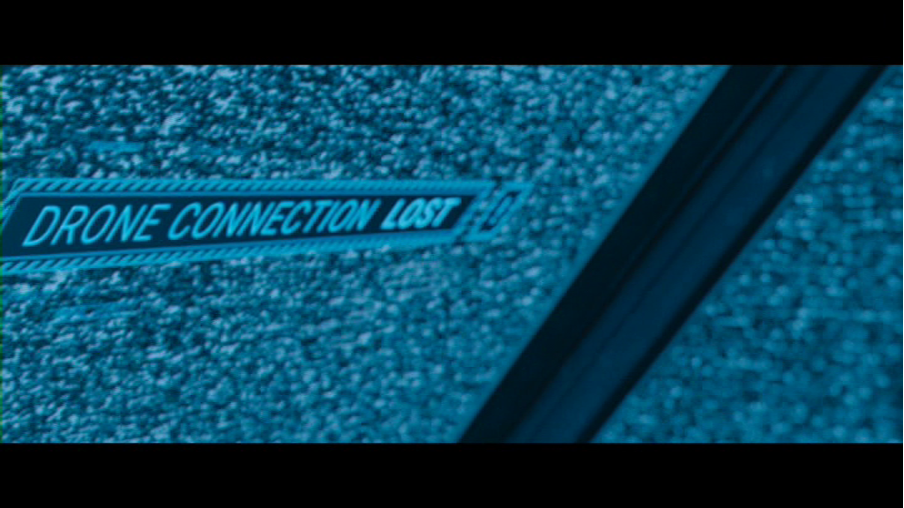
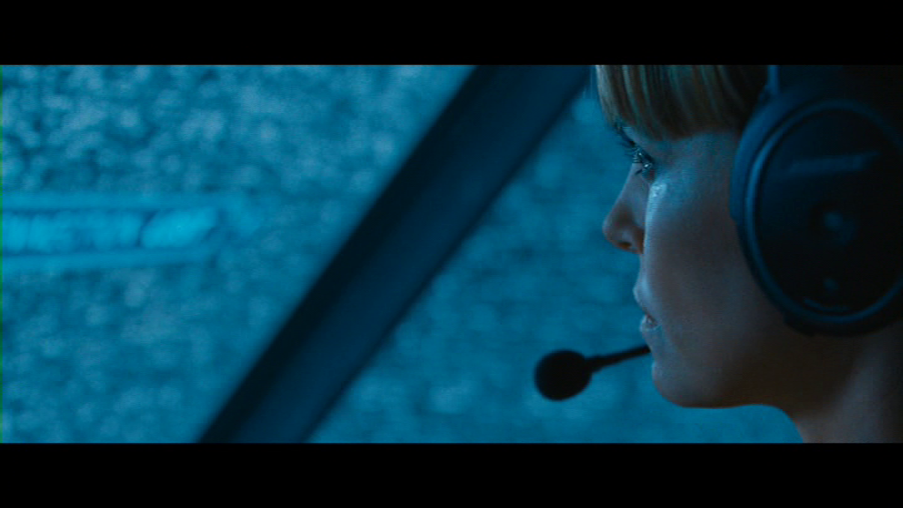
A cyberterrorist, Cipher represents a new type of enemy for the franchise's heroes, especially in the way she employs high-tech weapons to do her dirty work. When Dom appears to kill Cipher in F9, for instance, by torpedoing a 16-wheel truck into her plane, the film cuts to a shot from inside a virtual cockpit, revealing that she was actually piloting a drone (figs. 6. and 7). Cipher's reliance on remote technology is presented here as the ultimate betrayal: a repudiation of the franchise's underpinning ethos that "it's the rider that counts, not the ride."14
Coded as a member of the financial elite (the 1% of the 1%), Cipher is a world away from Dom and his team, a fact that's underscored by her headquarters — a futuristic aircraft from which she quite literally looks down on the streets that they call home. Operating out of this aircraft, Theron's villain is able to access almost any computer around the globe: midway through the film, for example, she hacks all of the self-driving cars in New York's Times Square, seizing control of the vehicles from their drivers and crashing them into one another. Equal parts Blofeld and the Joker, Cipher's true motivations are never entirely clear, but what we do glean from her monologues is that she plans to use the chaos of nuclear war as a means to extract money from the world's superpowers. Such prizing of money and political influence contrasts sharply with the philosophy of Dom and his team.
Across The Fast Saga, we are never shown the full extent of the heroes' financial resources. We know they make money flipping TV/DVD players in the first film, but their seemingly endless roster of both cars and property are never really justified in economic terms. A rare insight into their wealth comes after the successful heist at the end of Fast Five, a job that earns them $100 million collectively. However, this newfound fortune is downplayed in the opening moments of Fast & Furious 6, when we are shown the family living very similar lives to the ones they had before: Dom works on an engine at his new home while Tej is still up to old tricks, rigging an ATM in a Costa Rican town so that it dispenses free cash to the locals. It's only Roman who appears to be living the high life, partying with models on a private jet. But even he is quick to discard these luxuries, dropping them as soon as Dom calls for his help. This is one of many sequences that illustrate how, for these characters, work is about more than financial gain: it's about honor, "family" and, perhaps most importantly, the thrill of testing your skills. By removing money as a central motivation for its heroes, then, Fast & Furious offers up a curiously nostalgic vision of working-class labor, where the process itself is the reward.
The types of status and power that the team pursue cannot be bought. Instead, it's intangible things like honor and esteem that are most sought after by the protagonists. Dom confirms this at the start of The Fate of the Furious, when he turns down a car — his prize for winning a race against Cuban loan shark, Raldo (Celestino Cornielle) — because he'd rather have his opponent's "respect." Significantly, this interaction plays out in transactional terms: later in the film, Raldo repays Dom by helping him to defeat Cipher. Here, we see how the heroes trade on forms of non-institutionalized capital that they've accrued in the garage and on the streets — such as Dom's seemingly innate knowledge of how any car works, or the way in which his reputation as an elite racer precedes him, allowing him to call upon a vast network of allies around the globe. In this way, Sarah Thornton's concept of "subcultural capital" — a reconfiguration of the ideas of Pierre Bourdieu — helps to clarify the populist class politics that define The Fast Saga, namely, the clear distinction the series draws between the knowledge and skills of its street-racing heroes and those wielded by their white-collar and elite-coded adversaries.15
These forms of subcultural capital play a key role in the team's continued survival across the franchise, helping them to emerge victorious even as the stakes intensify with each new film. In The Fate of the Furious, for example, Dom's extensive knowledge of classic muscle cars proves vital to his attempts to evade Cipher. For much of the film, Dom drives a 1971 Plymouth GTX, a vehicle that predates the type of computer programming over which Cipher has mastery. So, while she can track Dom using her drones, Cipher is not able to hack his car. In a flashback sequence towards the end of the film, it's revealed that Dom rigged the car to misfire, simulating a breakdown that bought him vital minutes away from Cipher's watchful eye — minutes he used to plot his son's rescue. Once again, it's through his skills as both an auto mechanic and a street racer that Dom saves the day.
In the way that Dom and his team outsmart Cipher, foiling her plans at the end of both The Fate of the Furious and F9, the franchise reasserts the worth of street smarts and tenacity, showing that no amount of money and fancy gadgets can compete with a combination of strong gut instincts and hard work. As Dom states in The Fate of the Furious: "It doesn't matter what's under a hood. The only thing that matters is who's behind the wheel." This kind of homespun, rough-and-ready attitude is central to the franchise's appeal, helping to explain why the blue-collar superspies of Fast & Furious have proved popular over so many films.
Joshua Gulam (@joshua_gulam) is a Senior Lecturer in Film & Visual Culture at Liverpool Hope University.
Fraser Elliott (@harpozu) a Lecturer in Film Exhibition and Curation at University of Edinburgh.
Sarah Feinstein (@1000plateaus) is a Teaching Fellow in Performance and Cultural Industries at University of Leeds.
They are currently co-editing a book on Fast & Furious for Bloomsbury. Due to be published in February 2023, the book, entitled Full-Throttle Franchise, brings together a range of scholars to explore not only the style and themes of Fast & Furious, but also its broader cultural impact and industry legacy.
References
- See, for example, Mary Beltrán, "The New Hollywood Racelessness: Only the Fast,Furious, (and Multiracial) Will Survive," Cinema Journal 44, no. 2 (2005): 50-67; and Stuart Heritage, "Fragile masculinity: why no one in the Fast and Furious films can lose a fight," The Guardian, August 2, 2019.[⤒]
- Lin as quoted in Mary Beltrán, "Fast and Bilingual: Fast & Furious and the Latinization of Racelessness," Cinema Journal 53, no. 1 (2013): 75-96.[⤒]
- For more on the franchise's rebranding, see Joshua Gulam, Fraser Elliott and Sarah Feinstein, 'Researching Fast & Furious in the Franchise Era of Hollywood', in Full-Throttle Franchise: The Culture, Business and Politics of Fast & Furious, edited by Joshua Gulam, Fraser Elliott and Sarah Feinstein (New York: Bloomsbury, forthcoming 2023). [⤒]
- Location manager Bob Craft picked this house because it seemed to suit a "working-class, blue-collar guy trying to survive." Craft as quoted in Anna Scott, 'L.A. Dwellings: Toretto's House from "The Fast and the Furious"', KCRW, September 4, 2015. [⤒]
- See Harvey O'Brien, Action Movies: The Cinema of Striking Back (New York, NY: Columbia University Press, 2012). [⤒]
- Yvonne Tasker, "Dumb Movies for Dumb People: Masculinity, the Body, and the Voice in Contemporary Action Cinema," in Screening the Male: Exploring Masculinities in Hollywood Cinema, edited by Steven Cohan and Ina Rae Hark (London: Routledge, 1993), 239. [⤒]
- The exception here is Dwayne Johnson's Luke Hobbs, who is shown working out in a montage at the start of Fast & Furious Presents: Hobbs & Shaw (2019). However, the fact that Hobbs is a (former) federal agent means his coding as a blue-collar hero is very different to that of Dom. [⤒]
- Jon Kraszewski, "The 1980s Action Film and the Politics of Urban Expulsion," in A Companion to the Action Film, edited by James Kendrick (Hoboken: Wiley-Blackwell, 2019), 325-344. [⤒]
- Pete Deakin, White Masculinity in Crisis in Hollywood's Fin de Millennium Cinema (Lanham: Lexington, 2019), 59. [⤒]
- Deakin, White Masculinity, 37-69. [⤒]
- Importantly, not all of the blue-collar heroes in these 1980s' urban action films were white. Kraszewski also analyses the portrayal of African American characters such as Axel Foley (Eddie Murphy) in Beverly Hills Cop (1984). [⤒]
- Beltrán, "Fast and Bilingual," 94. For further discussion of the franchise's multiculturalism, see Pete Jones and Joshua Gulam, "A Critical Quantitative Analysis of Race and Representation in the Fast Saga films," in Full-Throttle Franchise: The Culture, Business and Politics of Fast & Furious, edited by Joshua Gulam, Fraser Elliott, and Sarah Feinstein (New York: Bloomsbury, forthcoming 2023).[⤒]
- Beltrán, "New Hollywood Racelessness," 59. See also Gary S. Cross, Machines of Youth: America's Car Obsession (Chicago: University of Chicago Press, 2018).[⤒]
- Adapted from a line of dialogue in The Fast and the Furious: Tokyo Drift (2006).[⤒]
- See Sarah Thornton, Club Cultures: Music, Media and Subcultural Capital (Cambridge: Polity Press, 1995). [⤒]
